Projector display systems having non-mechanical mirror beam steering
Gorny , et al. April 6, 2
U.S. patent number 10,969,742 [Application Number 16/710,691] was granted by the patent office on 2021-04-06 for projector display systems having non-mechanical mirror beam steering. This patent grant is currently assigned to Dolby Laboratories Licensing Corporation. The grantee listed for this patent is DOLBY LABORATORIES LICENSING CORPORATION. Invention is credited to Douglas J. Gorny, Martin J. Richards.
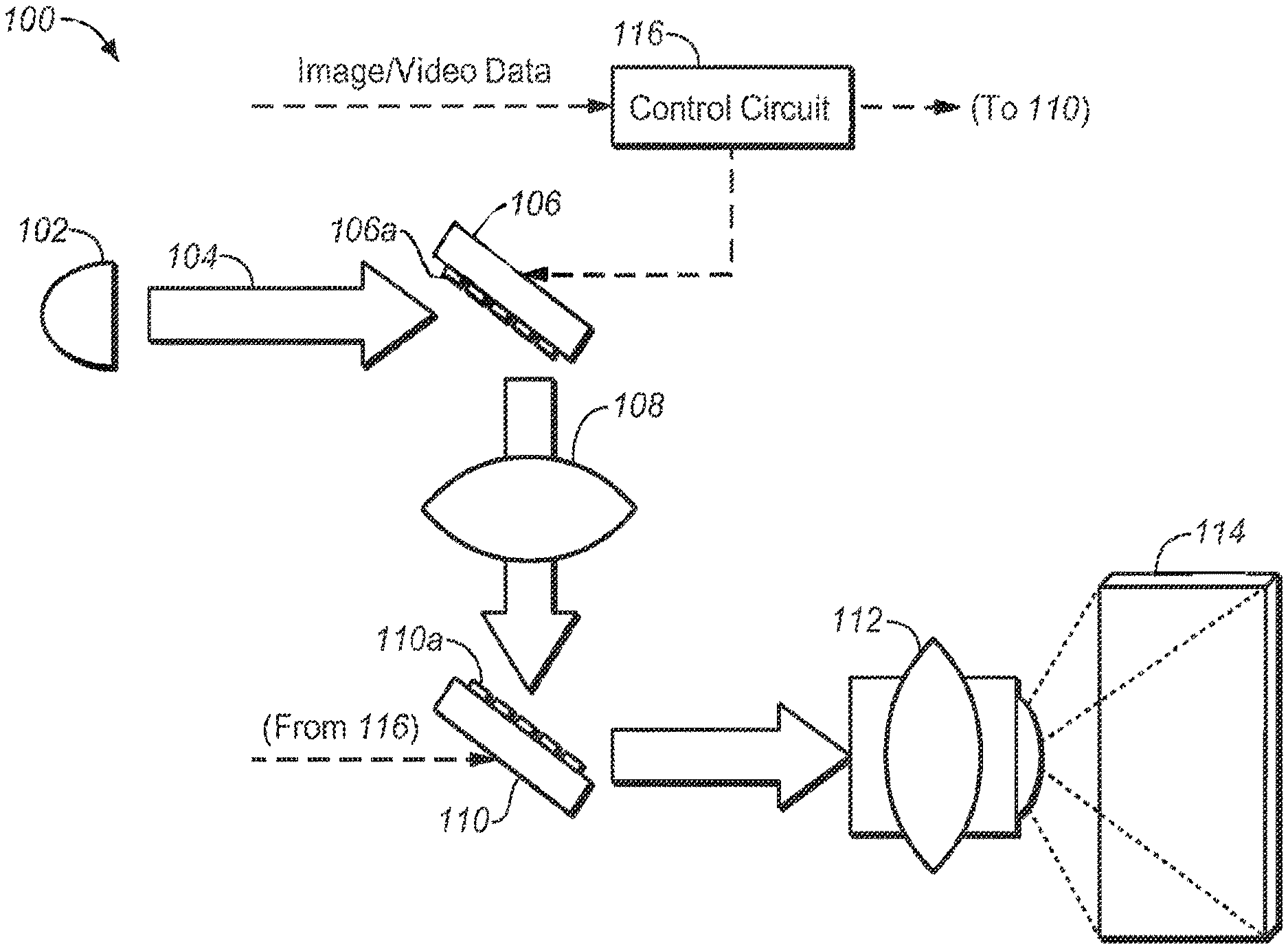
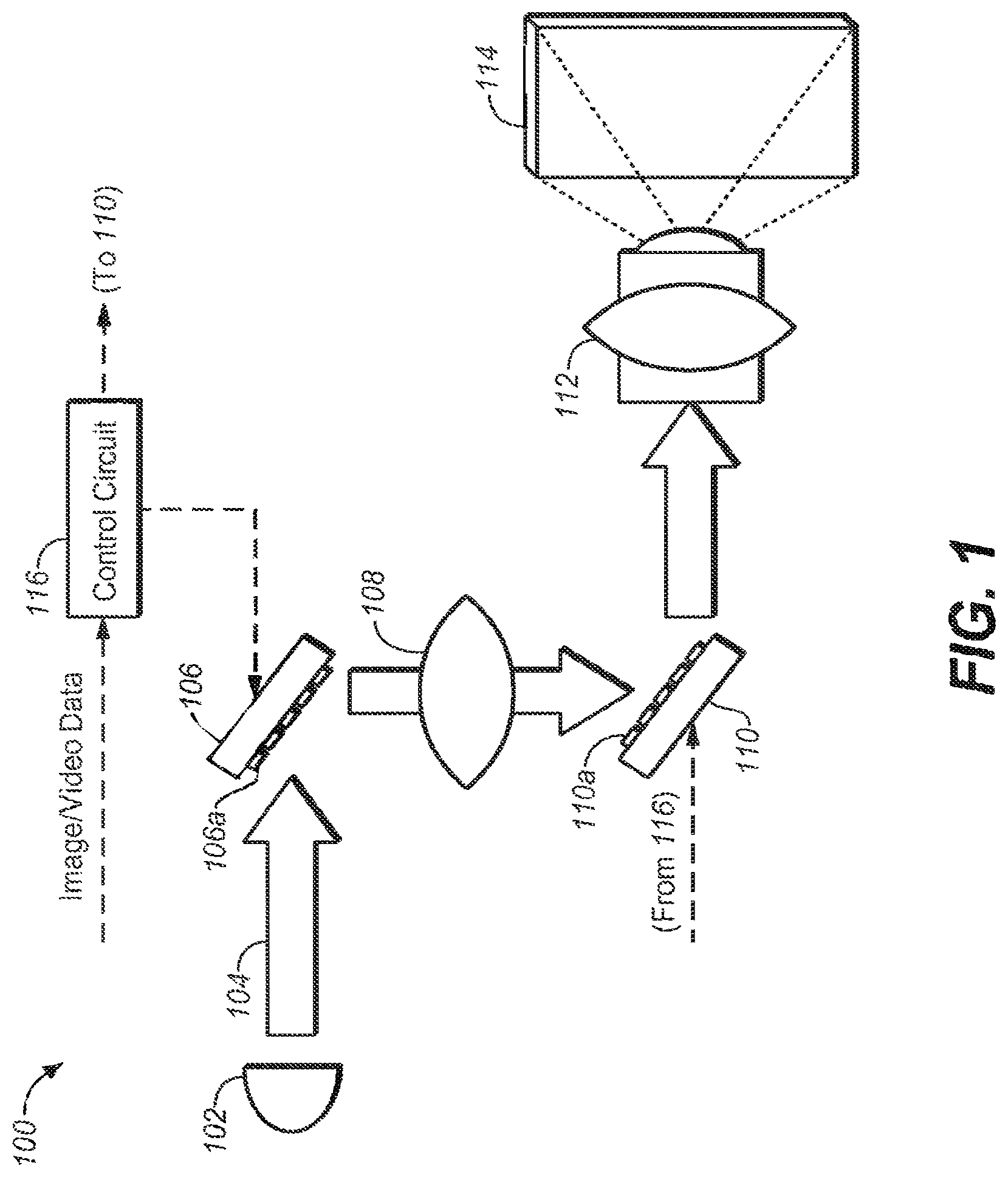
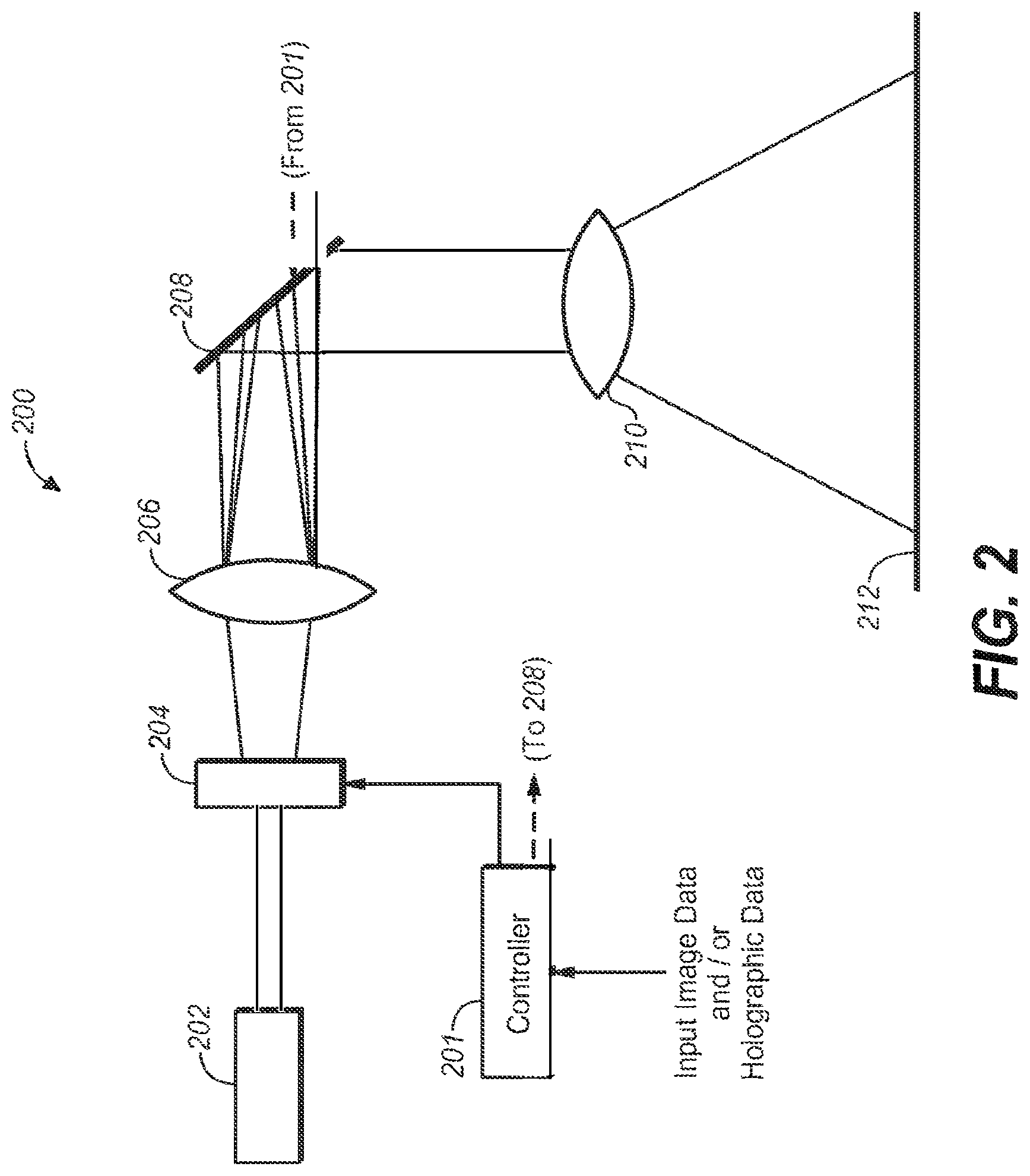
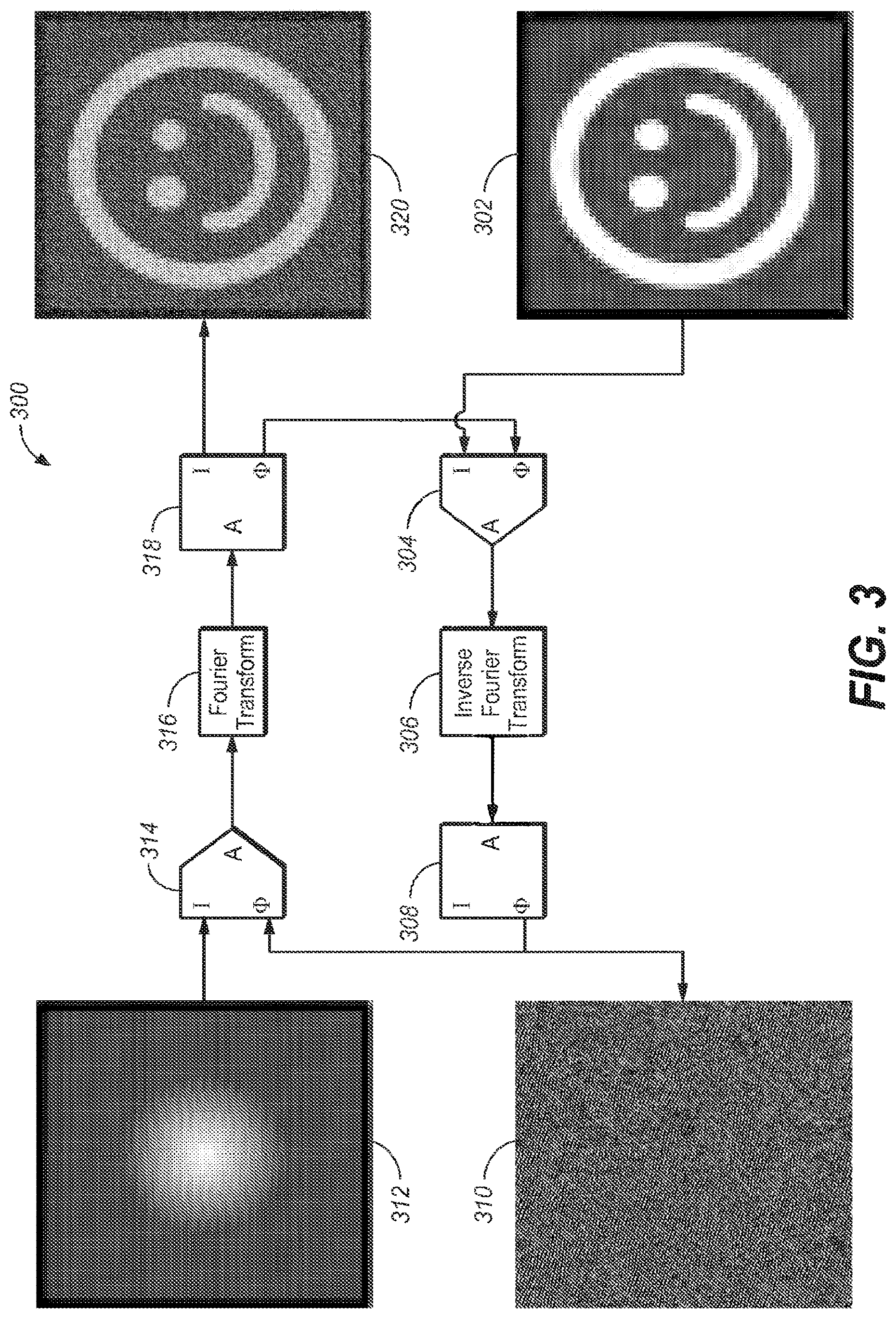
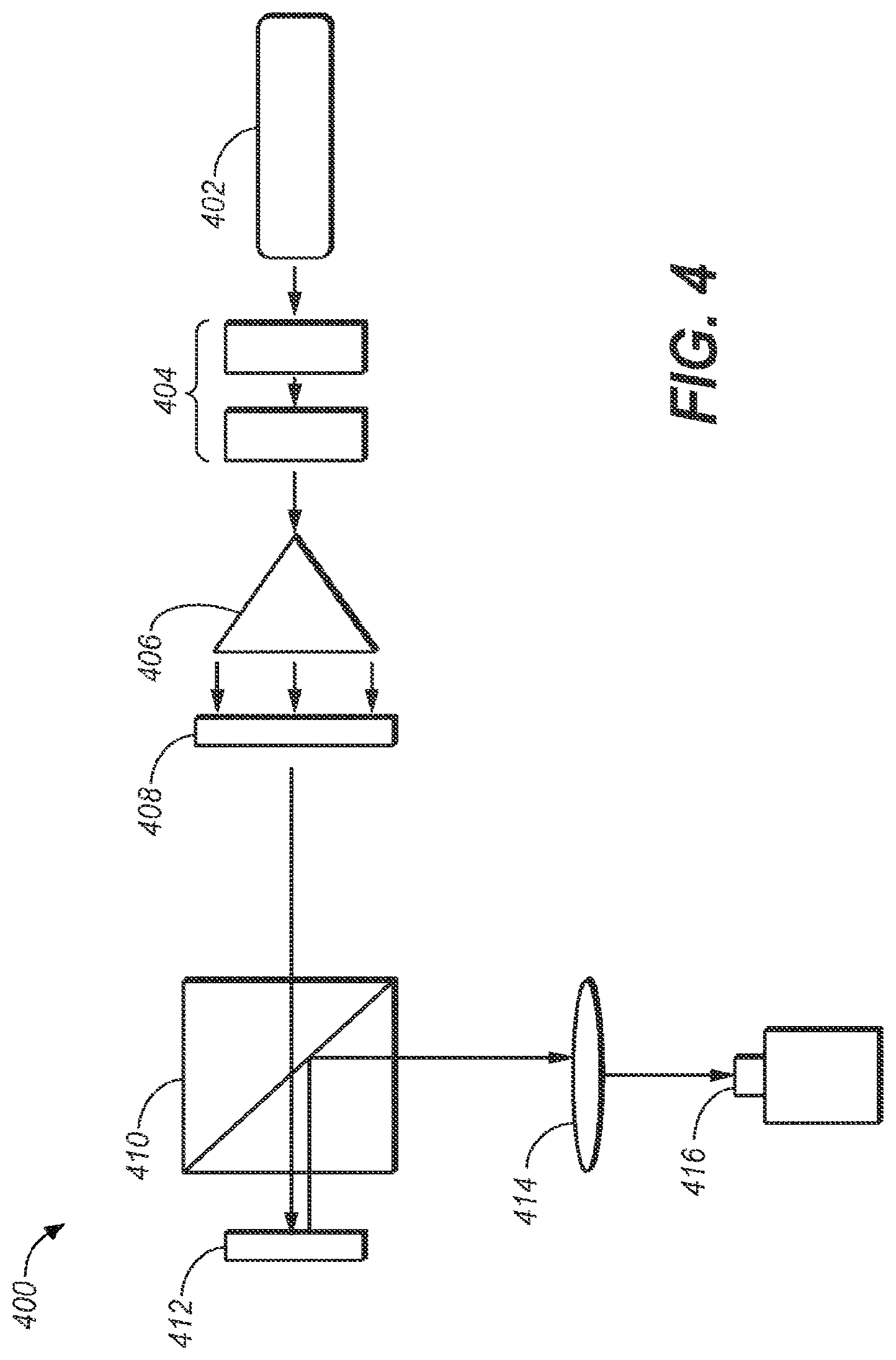
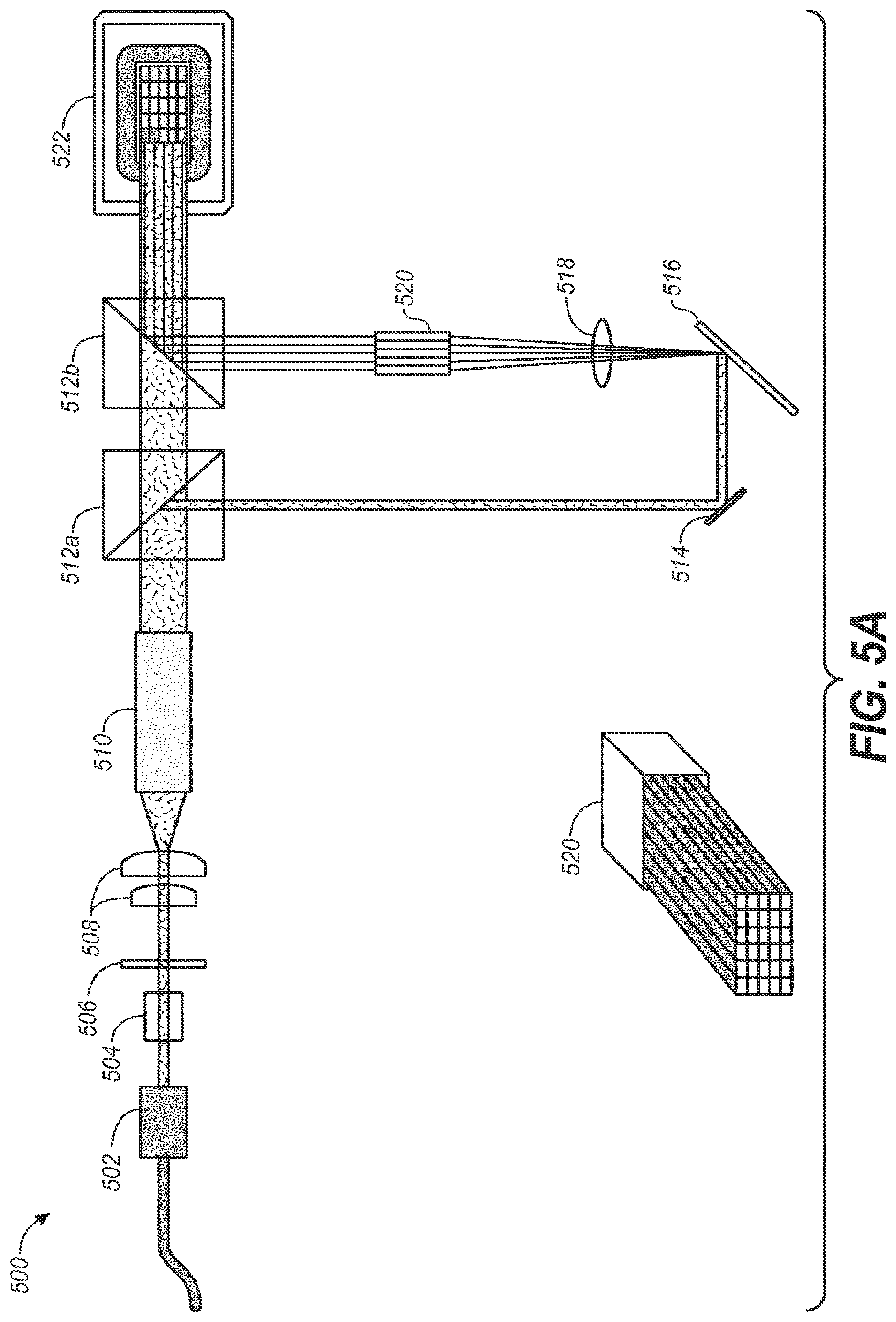
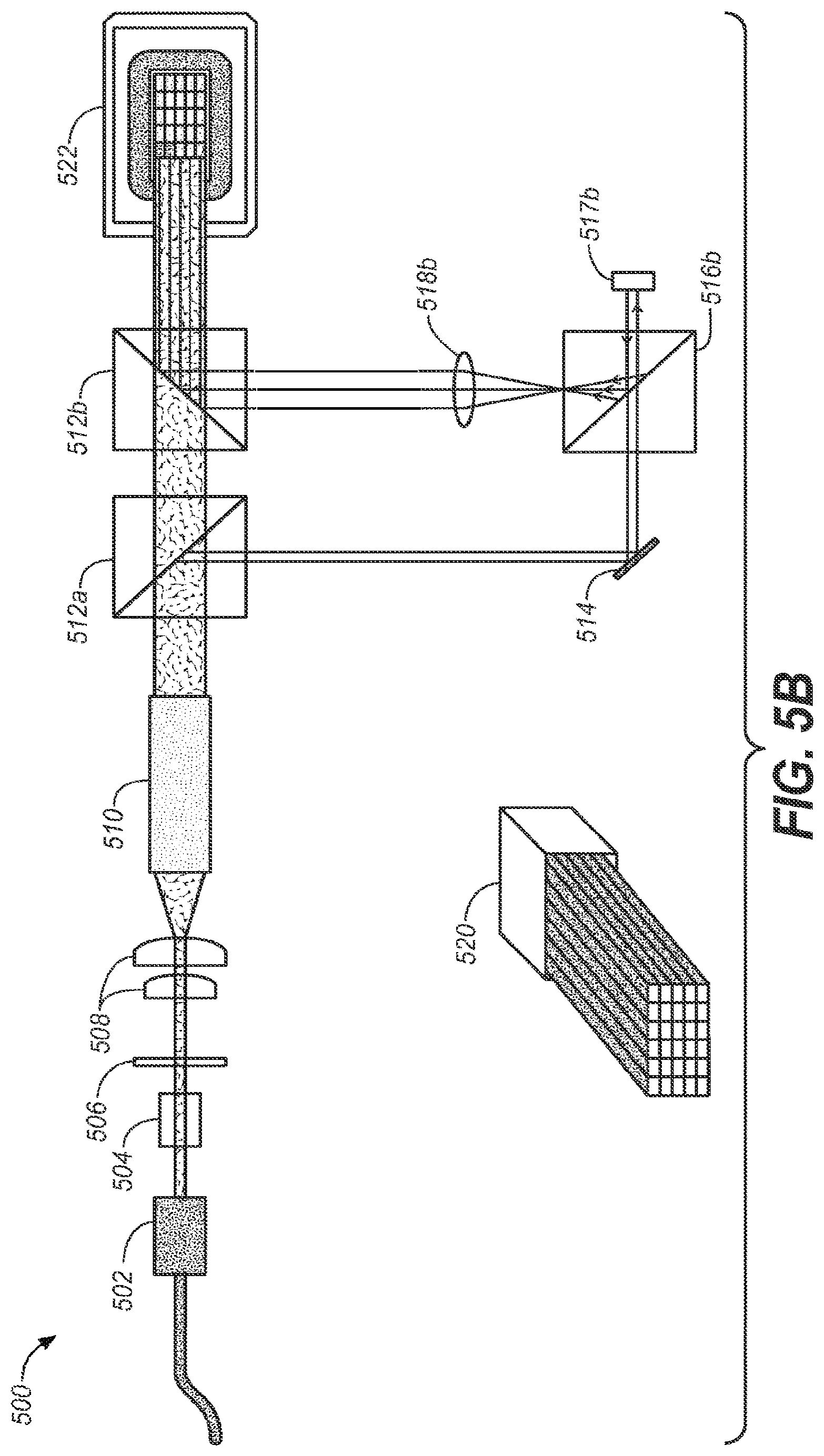
| United States Patent | 10,969,742 |
| Gorny , et al. | April 6, 2021 |
Projector display systems having non-mechanical mirror beam steering
Abstract
Dual or multi-modulation display systems are disclosed that comprise projector systems with at least one modulator that may employ non-mechanical beam steering modulation. Many embodiments disclosed herein employ a non-mechanical beam steering and/or polarizer to provide for a highlights modulator.
| Inventors: | Gorny; Douglas J. (Felton, CA), Richards; Martin J. (Redwood City, CA) | ||||||||||
|---|---|---|---|---|---|---|---|---|---|---|---|
| Applicant: |
|
||||||||||
| Assignee: | Dolby Laboratories Licensing
Corporation (San Francisco, CA) |
||||||||||
| Family ID: | 1000005469743 | ||||||||||
| Appl. No.: | 16/710,691 | ||||||||||
| Filed: | December 11, 2019 |
Prior Publication Data
| Document Identifier | Publication Date | |
|---|---|---|
| US 20200117138 A1 | Apr 16, 2020 | |
Related U.S. Patent Documents
| Application Number | Filing Date | Patent Number | Issue Date | ||
|---|---|---|---|---|---|
| 15960099 | Apr 23, 2018 | 10534316 | |||
| 14904946 | May 29, 2018 | 9983545 | |||
| PCT/US2014/048479 | Jul 28, 2014 | ||||
| 61979248 | Apr 14, 2014 | ||||
| 61860203 | Jul 30, 2013 | ||||
| Current U.S. Class: | 1/1 |
| Current CPC Class: | G02B 27/281 (20130101); G02B 26/0833 (20130101); G03B 21/2026 (20130101); G02B 5/3025 (20130101); G03B 21/28 (20130101); G03B 21/208 (20130101); H04N 9/3102 (20130101); G03B 21/2073 (20130101); G02B 26/02 (20130101); G03B 21/2033 (20130101); G03H 1/2294 (20130101); H04N 9/3179 (20130101); H04N 9/3126 (20130101); G03H 1/0005 (20130101); G03H 1/0808 (20130101); G02B 27/09 (20130101); G03H 2001/0816 (20130101); G02B 27/10 (20130101) |
| Current International Class: | G03H 1/08 (20060101); G02B 26/02 (20060101); G03B 21/28 (20060101); G03B 21/20 (20060101); G03H 1/00 (20060101); G03H 1/22 (20060101); H04N 9/31 (20060101); G02B 5/30 (20060101); G02B 26/08 (20060101); G02B 27/28 (20060101); G02B 27/09 (20060101); G02B 27/10 (20060101) |
References Cited [Referenced By]
U.S. Patent Documents
| 5428417 | June 1995 | Lichtenstein |
| 5504575 | April 1996 | Stafford |
| 5986640 | November 1999 | Baldwin |
| 6088321 | July 2000 | Yamaji |
| 6337760 | January 2002 | Huibers |
| 6373806 | April 2002 | Kitamura |
| 6535472 | March 2003 | Lee |
| 7050122 | May 2006 | Gibbon et al. |
| 7126736 | October 2006 | Itoh |
| 7346234 | March 2008 | Davis |
| 7551341 | June 2009 | Ward |
| 7812959 | October 2010 | Kim |
| 7986603 | July 2011 | Trisnadi |
| 8199387 | June 2012 | Aye |
| 8366275 | February 2013 | Harding |
| 8783874 | July 2014 | Riza |
| 9049413 | June 2015 | Richards |
| 9531982 | December 2016 | Richards |
| 9983545 | May 2018 | Gorny |
| 10534316 | January 2020 | Gorny |
| 2001/0017836 | August 2001 | Itoh |
| 2003/0016335 | January 2003 | Penn |
| 2004/0001184 | January 2004 | Gibbons |
| 2005/0169094 | August 2005 | Itoh |
| 2005/0190140 | September 2005 | Asahi et al. |
| 2005/0286101 | December 2005 | Garner |
| 2006/0092380 | May 2006 | Salsman |
| 2006/0164705 | July 2006 | Itoh |
| 2007/0058143 | March 2007 | Penn |
| 2007/0120786 | May 2007 | Bells |
| 2007/0146846 | June 2007 | Yasuda |
| 2007/0268224 | November 2007 | Whitehead |
| 2007/0285587 | December 2007 | Seetzen |
| 2008/0024848 | January 2008 | Kawano |
| 2008/0043303 | February 2008 | Whitehead |
| 2008/0174860 | July 2008 | Yelleswarapu |
| 2008/0180465 | July 2008 | Whitehead |
| 2008/0185978 | August 2008 | Jeong |
| 2008/0186308 | August 2008 | Suzuki |
| 2008/0204834 | August 2008 | Hill |
| 2008/0231936 | September 2008 | Endo |
| 2008/0239419 | October 2008 | Tachibana |
| 2008/0246705 | October 2008 | Russell |
| 2008/0246783 | October 2008 | Endo |
| 2009/0103151 | April 2009 | Horikawa |
| 2009/0135314 | May 2009 | Hui |
| 2009/0141189 | June 2009 | Shirai |
| 2009/0141194 | June 2009 | Shirai |
| 2009/0225234 | September 2009 | Ward |
| 2009/0244499 | October 2009 | Bartlett |
| 2009/0278918 | November 2009 | Marcus |
| 2009/0284671 | November 2009 | Leister |
| 2010/0014134 | January 2010 | Cable |
| 2010/0039918 | February 2010 | Tanaka |
| 2010/0046050 | February 2010 | Kroll |
| 2010/0103246 | April 2010 | Schwerdtner |
| 2010/0118360 | May 2010 | Leister |
| 2010/0149139 | June 2010 | Kroll |
| 2010/0149311 | June 2010 | Kroll |
| 2010/0157399 | June 2010 | Kroll |
| 2010/0165429 | July 2010 | Buckley |
| 2010/0214282 | August 2010 | Whitehead |
| 2010/0253677 | October 2010 | Kroll |
| 2011/0227900 | September 2011 | Wallener |
| 2011/0251905 | October 2011 | Lawrence |
| 2011/0273495 | November 2011 | Ward |
| 2011/0279749 | November 2011 | Erinjippurath |
| 2012/0008181 | January 2012 | Cable |
| 2012/0092624 | April 2012 | Oiwa |
| 2012/0105929 | May 2012 | Sung |
| 2012/0133689 | May 2012 | Kwong |
| 2012/0140446 | June 2012 | Seetzen |
| 2012/0188467 | July 2012 | Escuti |
| 2012/0188620 | July 2012 | De Echaniz |
| 2012/0219021 | August 2012 | Lippey |
| 2013/0050409 | February 2013 | Li |
| 2013/0100333 | April 2013 | Awatsuji |
| 2013/0106923 | May 2013 | Shields et al. |
| 2013/0148037 | June 2013 | Whitehead |
| 2013/0215730 | August 2013 | Okamoto |
| 2013/0265554 | October 2013 | Baranec |
| 2014/0043352 | February 2014 | Damberg |
| 2015/0002750 | January 2015 | Toyooka |
| 2015/0346491 | December 2015 | Christmas |
| 2016/0077339 | March 2016 | Christmas |
| 2016/0381329 | December 2016 | Damberg |
| 1700085 | Nov 2005 | CN | |||
| 101076705 | Nov 2007 | CN | |||
| 101076705 | Nov 2007 | CN | |||
| 101822043 | Sep 2010 | CN | |||
| 101822043 | Sep 2010 | CN | |||
| 102749793 | Oct 2012 | CN | |||
| 103080831 | May 2013 | CN | |||
| 103080831 | May 2013 | CN | |||
| 2485609 | May 2012 | GB | |||
| 2005241905 | Sep 2005 | JP | |||
| 2006208923 | Aug 2006 | JP | |||
| 2008544307 | Dec 2008 | JP | |||
| 2009539138 | Nov 2009 | JP | |||
| 2011514546 | May 2011 | JP | |||
| 2011528132 | Nov 2011 | JP | |||
| 2005071654 | Aug 2005 | WO | |||
| 2010125367 | Nov 2010 | WO | |||
| 2012145200 | Oct 2012 | WO | |||
| 2013094011 | Jun 2013 | WO | |||
| WO-2017054342 | Apr 2017 | WO | |||
Other References
|
Amako et al., "Wave-front control using liquid-crystal devices," Applied Optics, vol. 32, No. 23, Aug. 10, 1993, pp. 4323-4329. cited by applicant . Amako, J. et al "Wave-Front Control Using Liquid-Crystal Devices" Aug. 10, 1993, vol. 32, No. 23, Applied Optics, pp. 4323-4329. cited by applicant . Amako, J. et al "Wave-front Control Using Liquid-Crystal Devices" vol. 32, Issue 23, pp. 4323-4329, Aug. 10, 1993. cited by applicant . I.V. Il''lina et al "Gerchberg-Saxton Algorithm: Experimental Realisation and Modification for the Problem of Formation of Multimode Laser Beams, Quantum Electronics",39,No. 6, 209, pp. 521-527. cited by applicant. |
Primary Examiner: Aghevli; Reza
Parent Case Text
CROSS REFERENCE TO RELATED APPLICATIONS
This application is a continuation of U.S. Non-Provisional application Ser. No. 15/960,099, filed 23 Apr. 2018, which is a continuation of U.S. Non-Provisional application Ser. No. 14/904,946, filed 13 Jan. 2016, which is a 371 U.S. National phase of PCT/US2014/048479, filed 28 Jul. 2014, which claims priority to U.S. Provisional Patent Application No. 61/860,230, filed on 30 Jul. 2013 and U.S. Provisional Patent Application No. 61/979,248, filed on 14 Apr. 2014, each of which is hereby incorporated by reference in its entirety.
Claims
The invention claimed is:
1. A hologram image generator comprising: a first modulator configured to modulate light received from a light source to produce modulated light; a lens configured to inverse Fourier transform said modulated light to produce inverse-Fourier-transformed light; and a second modulator configured to modulate said inverse-Fourier-transformed light, wherein the lens is disposed along an optical path between the first modulator and the second modulator.
2. The hologram image generator according to claim 1, further comprising a controller including: a processor; and a memory associated with said processor and comprising processor-readable instructions that, when said processor reads said processor-readable instructions, causes said processor to perform the following functions: (a) receive holographic data, and (b) send control signals to said first modulator to impose spatially-varying phase shifts on said light received from said light source, according to said holographic data.
3. The hologram image generator according to claim 1, further comprising an optical element configured to provide a global dimming on said light from said light source.
4. The hologram image generator according to claim 3, wherein the optical element is a polarizer configured to adjust an intensity of said light from said light source.
5. The hologram image generator according to claim 1, further comprising a beam spreader configured to spread out said light from said light source.
6. The hologram image generator according to claim 1, further comprising a half-wave plate configured to polarize said light from said light source.
7. The hologram image generator according to claim 6, further comprising a polarizing beam splitter configured to allow said polarized light from said half-wave plate to reach said first modulator, and to redirect said modulated light from said first modulator toward said lens.
8. The hologram image generator according to claim 1, wherein said first modulator includes an array of mechanically-actuated mirrors.
9. The hologram image generator according to claim 1, wherein said light from said light source is a coherent or partially coherent light.
10. The hologram image generator according to claim 1, wherein said image capture device is configured to generate a holographic representation of an input image based on said modulated inverse-Fourier-transformed light.
Description
TECHNICAL FIELD
The present invention relates to displays systems and, more particularly, to dual or multi-stage modulation projection display systems possibly employing highlight modulation.
BACKGROUND
In a conventional multi-stage modulation projector system, there is typically a single light source that illuminates a screen with an image that is modulated by some optical system within the projector. In such conventional multi-stage modulation projector systems, it is typical that the highlights modulator is a MEMS array--or some other means of mechanical beam steering. Highlight modulators have the ability to steer the light reaching their individual steering elements to any arbitrary location in the following light path. Merely for one example, a highlights modulator may be able to steer more light onto a portion of a projected image that has a higher luminance that surrounding parts of the image--thus, that portion would be "highlighted".
In the context of these dual/multi-modulator projector systems, it may be possible to construct such a projector system with at least one highlights modulator that may possibly employ non-mechanical beam steering that does not necessary rely on moveable mirror(s).
SUMMARY
Several embodiments of display systems and methods of their manufacture and use are herein disclosed.
In one embodiment, a projector display system, said display system comprising: a light source; a controller; a first holographic modulator, said first modulator being illuminated by said light source and said first modulator comprising a holographic imaging module; a lens, said lens adapted to transmit from said first holographic modulator; a second modulator, said second modulator being illuminated by light from said lens and capable of modulating light from said lens, and said second modulator comprising a plurality of mirrors; said controller further comprising: a processor; a memory, said memory associated with said processor and said memory further comprising processor-readable instructions, such that when said processor reads the processor-readable instructions, causes the processor to perform the following instructions: receiving image data; sending control signals to said first holographic modulator such that said first holographic modulator may allocate a desired proportion of the light from said light source onto said second modulator; and sending control signals to said second modulator such that said desired proportion of the light from said light source is modulated to form said desired image for projection.
In another embodiment, projector display system, said display system comprising: a light source; a controller; a polarizer, said polarizer being illuminated by said light source and said polarizer inducing a desired polarization to the light from said light source; a beam expander, said beam expander expanding said light from said polarizer; a first partial beam splitter, said first partial beam splitter capable of splitting the light preferentially along a main light path and a highlight path; a spatial light modulator, said spatial light modulator receiving said light along said highlight path and modulating said light along said highlight path to create a desired highlight light; a second partial beam splitter, said second partial beam splitter capable of combining light from said main light path and said highlight path; said controller further comprising: a processor; a memory, said memory associated with said processor and said memory further comprising processor-readable instructions, such that when said processor reads the processor-readable instructions, causes the processor to perform the following instructions: receiving image data, said image data potentially comprising at least one highlight feature; sending control signals to said spatial light modulator, such that said spatial light modulator may send a desired amount of highlight light to be combined with light from the main light path at said second partial beam splitter to form said highlight feature.
Other features and advantages of the present system are presented below in the Detailed Description when read in connection with the drawings presented within this application.
BRIEF DESCRIPTION OF THE DRAWINGS
Exemplary embodiments are illustrated in referenced figures of the drawings. It is intended that the embodiments and figures disclosed herein are to be considered illustrative rather than restrictive.
FIG. 1 is one embodiment of a dual/multi-modulator projector display system that employs two moveable mirror assemblies that may take advantage of a highlights modulator.
FIG. 2 is one embodiment of a dual/multi-modulator projector display system that employs a holographic imaging module as at least one non-mechanical means for steering beams of light, as made in accordance with the principles of the present application.
FIG. 3 is one embodiment of a system and/or method for creating holograms for holographic imaging that affects the desired beam steering in the display system of FIG. 2.
FIG. 4 is another embodiment of a system for creating the holographic imaging that affects the desired beam steering in the display system of FIG. 2.
FIG. 5A is one embodiment of a dual/multi-modulator projector display system that may employ a polarizer to adjust the balance of light between a main light path and a highlight light path, as made in accordance with the principles of the present application.
FIG. 5B is yet another embodiment of a dual/multi-modulator projector system that may employ a polarizer to adjust the balance of light between a main light path and a highlight light path using a non-mechanical beam steering modulator, as made in accordance with the principles of the present application
DETAILED DESCRIPTION
Throughout the following description, specific details are set forth in order to provide a more thorough understanding to persons skilled in the art. However, well known elements may not have been shown or described in detail to avoid unnecessarily obscuring the disclosure. Accordingly, the description and drawings are to be regarded in an illustrative, rather than a restrictive, sense.
As utilized herein, terms "component," "system," "interface," "controller" and the like are intended to refer to a computer-related entity, either hardware, software (e.g., in execution), and/or firmware. For example, any of these terms can be a process running on a processor, a processor, an object, an executable, a program, and/or a computer. By way of illustration, both an application running on a server and the server can be a component and/or controller. One or more components/controllers can reside within a process and a component/controller can be localized on one computer and/or distributed between two or more computers.
The claimed subject matter is described with reference to the drawings, wherein like reference numerals are used to refer to like elements throughout. In the following description, for purposes of explanation, numerous specific details are set forth in order to provide a thorough understanding of the subject innovation. It may be evident, however, that the claimed subject matter may be practiced without these specific details. In other instances, well-known structures and devices are shown in block diagram form in order to facilitate describing the subject innovation.
INTRODUCTION
Current dual/multi-modulator projector display systems comprise two or more modulation stages where illuminating light is passed in order to form a final projected image upon a projection screen. For the most part, such modulation stages comprise mechanical beam steering architectures--e.g., DMD, MEMS or some mechanically actuated set of mirrors. FIG. 1 depicts an embodiment of a dual/multi-modulator projector display system that employs mechanical beam steering modulators.
Projector system 100 employs a light source 102 that supplies the projector system with a desired illumination such that a final projected image will be sufficiently bright for the intended viewers of the projected image. Light source 102 may comprise any suitable light source possible--including, but not limited to: Xenon lamp, laser(s), LEDs, coherent light source, partially coherent light sources.
Light 104 may illuminate a first modulator 106 that may, in turn, illuminate a second modulator 110, via a set of optional optical components 108. Light from second modulator 110 may be projected by a projection lens 112 (or other suitable optical components) to form a final projected image upon a screen 114. First and second modulators may be controlled by a controller 116--which may receive input image and/or video data. Controller 116 may perform certain image processing algorithms, gamut mapping algorithms or other such suitable processing upon the input image/video data and output control/data signals to first and second modulators in order to achieve a desired final projected image 114. In addition, in some projector systems, it may be possible, depending on the light source, to modulate light source 102 (control line not shown) in order to achieve additional control of the image quality of the final projected image.
First modulator 106 and second modulator 110 may comprise a set of mechanically moveable mirrors 106a and 110a, respectively--e.g., as may form a DMD or MEMS array. These mirrors may be moved or otherwise actuated according to control signals received from the controller 116. Light may be steered by the first and second modulators as desired by such mechanical actuation.
Dual modulation projector and display systems have been described in commonly-owned patents and patent applications, including:
(1) U.S. Pat. No. 8,125,702 to Ward et al., issued on Feb. 28, 2012 and entitled "SERIAL MODULATION DISPLAY HAVING BINARY LIGHT MODULATION STAGE";
(2) United States Patent Application 20130148037 to Whitehead et al., published on Jun. 13, 2013 and entitled "PROJECTION DISPLAYS";
(3) United States Patent Application 20110227900 to Wallener, published on Sep. 22, 2011 and entitled "CUSTOM PSFs USING CLUSTERED LIGHT SOURCES";
(4) United States Patent Application 20130106923 to Shields et al., published on May 2, 2013 and entitled "SYSTEMS AND METHODS FOR ACCURATELY REPRESENTING HIGH CONTRAST IMAGERY ON HIGH DYNAMIC RANGE DISPLAY SYSTEMS";
(5) United States Patent Application 20110279749 to Erinjippurath et al., published on Nov. 17, 2011 and entitled "HIGH DYNAMIC RANGE DISPLAYS USING FILTERLESS LCD(S) FOR INCREASING CONTRAST AND RESOLUTION" and
(6) United States Patent Application 20120133689 to Kwong, published on May 31, 2012 and entitled "REFLECTORS WITH SPATIALLY VARYING REFLECTANCE/ABSORPTION GRADIENTS FOR COLOR AND LUMINANCE COMPENSATION". all of which are hereby incorporated by reference in their entirety.
In addition, there are references that disclose the use of holographic projection and the Fourier nature of the illumination to create projector display system such as:
(1) United States Patent Application 20140043352 to Damberg et al., published on Feb. 13, 2014 and entitled "HIGH LUMINANCE PROJECTION DISPLAYS AND ASSOCIATED METHODS";
(2) United States Patent Application 20100157399 to Kroll et al., published on Jun. 24, 2010 and entitled "HOLOGRAPHIC DISPLAY";
(3) United States Patent Application 20100046050 to Kroll et al., published on Feb. 25, 2010 and entitled "COMPACT HOLOGRAPHIC DISPLAY DEVICE";
(4) United States Patent Application 20120008181 Cable et al., published on Jan. 12, 2012 and entitled "HOLOGRAPHIC IMAGE DISPLAY SYSTEMS";
(5) United States Patent Application 20120188620 to De Echaniz et al., published on Jul. 26, 2012 and entitled "LASER IMAGE PROJECTION SYSTEM APPLICABLE TO THE MARKING OF OBJECTS AND METHOD FOR GENERATING HOLOGRAMS" all of which are hereby incorporated by reference in their entirety.
Non-Mechanical Beam Steering Embodiments
Non-mechanical beam steering modulators, as opposed to mechanical modulators, may not have need of MEMS devices but instead leverage more common imaging devices such as LCD modulators. In particular, it may be desirable to have at least one or more modulator stages that do not comprise a moveable arrangement of mirrors.
FIG. 2 depicts one embodiment of a suitable projector system (200) comprising at least one non-mechanical beam steering module. Projector system 200 comprises a light source 202 that may comprise laser(s), LEDs, coherent or partially coherent light source(s)--e.g., where the light may be of the same wavelength and phase. It suffices that, whatever light is produced from source 202, that light is able to sufficiently interact with a holographic image to affect the beam of the light.
Light from source 202 illuminates first holographic modulator 204. First modulator 204 may comprise an LCD panel or any other module that is capable of forming a holographic image thereon and interacting with the light from source 202. First modulator 204 may receive its holographic image from controller 201--which, in turn, may either derive holographic data and/or control signals from input image data--or may receive holographic data from the input data stream that may accompany the input image data, if needed. As will be discussed further herein, holographic data may be derived through an iterative process that may reside inside the controller or may be sent to the controller from an outside process.
The light passing through the first modulator 204 may illuminate a lens (and/or optical subsystem) 206. Lens 206 may affect a Fourier transformation of the illumination such that desired beam steering may be affected onto a second modulator 208. The light from lens 206 may be beam steered in a desired spatio-temporal fashion that allows the projector system to perform a highlight illumination of any desired feature within the projected image. For example, if there is a desired specular reflection (or any other suitable feature with higher luminance that other features) within an finally projected image, then non-mechanical beam steering employing holographic image processing is capable of steering the beam in a timely fashion to provide additional illumination to the highlight features in the finally projected image.
Second modulator 208 may be any known modulator--e.g., DMD, MEMS and/or any set of moveable mirrors, such that the light modulated by modulator 208 (according to control signals from controller 201) may be processed by projection lens 210 and finally projected onto screen 212 for viewing.
One Holographic Data Processing Embodiment
As mentioned above, the holographic data may be derived from input image data in on-board or off-line process. FIG. 3 depicts one embodiment of an iterative processing system 300 (called the Gerchberg-Saxton algorithm, a description of which may be found at http://en.wikipedia.org/wiki/Gerchberg % E2%80%93Saxton_algorithm) by which holographic data may be derived from input image data.
Suppose input image 302 is the desired image to be modeled and/or rendered by a display system. The holographic processing system 300 would input image data 302 into a circuit and would be placed through an inverse Fourier Transform process 306 in order to create a holographic representation 310 of the input image 302.
As may be seen, holographic image 310 may appear to a human viewer as a jumbled and perhaps disordered image, it in fact captures the information content of the input image--but in the frequency domain. This frequency information (e.g., Fourier coefficients) may be input into a processing block 314--together with amplitude model of the light from source 202 (312). The output of processing block 314 may be taken into a Fourier Transform process 316 producing the resulting 320 which is an approximation of 302. The difference between is 302 and 320 is calculated in processing block 304 and used to refine the image sent to 306 to reiterate the process until the error between 320 and 302 is within tolerance. Once this is achieved 310 can be used as the holographic data applied to 204.
As mentioned, this process may be performed in real-time at the controller 201 based on input image data or it may be supplied to the controller via some off-line process.
FIG. 4 is one embodiment of a hologram image generator 400, as made in accordance with the principles of the present application. Generator 400 may comprise a laser light source 402 (or some suitable coherent or partially coherent light source). The light may transmit through one or more optional polarizers 404 to adjust the intensity of the light from source 402. It should be noted that this may not be a requirement of a generic system; but may provide a sort of global dimming feature. The light may be spread out accordingly with optical element 406. This light may then pass through a half-wave plate 408 to polarize the light as desired to be used by the polarizing beam splitter 410. Splitter 410 allows the polarized light from 408 to reach Spatial Light Modulator (SLM) 412 and then redirects the light reflected off 412 to 414. SLM 412 phase shifts the light from 408 according to the holographic data applied to it. Lens 414 performs an inverse Fourier transform on the phase shifted light producing the desired image at image capture 416. Image capture 416 is shown as a camera but may also be a subsequent modulator in a multi-modulation system.
Rotatable Polarization Plate Embodiment for Beam Steering
Apart from holographic means of beam steering, there are other non-mechanical beam steering modules that may be suitable in a dual/multi-modulation projection display system.
There are described in the following reference the use of a rotatable polarizer as a means to affect beam steering: (1) United States Patent Application 20130265554 to BARANEC et al., published on Oct. 10, 2013 and entitled "COMPACT LASER PROJECTION SYSTEMS AND METHODS"; and (2) United States Patent Application 20120188467 to Escuti et al., published on Jul. 26, 2012 and entitled "BEAM STEERING DEVICES INCLUDING STACKED LIQUID CRYSTAL POLARIZATION GRATINGS AND RELATED METHODS OF OPERATION" all of which are hereby incorporated by reference in their entirety.
FIG. 5A depicts one such embodiment that may employ a polarization plate (e.g., either fixed or rotatable) that affects desired beam steering as discussed herein. In one embodiment, projection display system 500 may comprise a laser (or some coherent/partially coherent) light source 502, polarization recovery optics (PRO) 504, rotatable polarizer 506, beam forming/expanding lenses 508, integrating rod (or alternatively, a beam expander) 510, partial beam splitter 512a, mirror 514, MEMS array 516, lens 518, stack rod array 520, partial beam splitter 512b, and DMD array 522.
Array 522 may serve as a second and/or additional modulator to provide additional light processing for finally projection of a final image (and possibly, through additional optical elements and/or components). The components from 502 to 512a may provide a light path directly to 512b--e.g., as a main beam providing substantially all of the desired illumination for the finally projected image. However, depending on polarization of the light from integrating rod(s) 510, a second light path (e.g., down to element 514) may be employed, e.g., for a highlight illumination path that eventually may be recombined with the main beam at 512b e.g., to provide a desired amount and placement of highlight illumination.
FIG. 5A depicts using polarization to control the amount of uniform light directly reaching the next stage of modulation and the amount of light reaching the highlights modulator which is then sorted into discrete bins (e.g., as seen as the segments comprising 520) and that resulting non-uniform light field may be applied to the next stage of modulation. As may also be seen, MEMS device 516 may be used to sort the light reaching it into discrete segments in 520. In another embodiment, it may be possible to replace 516, 518, and 520 with elements 410, 412 and 414--e.g., in the case of non-mechanical beam steering.
In operation, laser light from 502 illuminates the optical subsystem 504 and 506. The light illuminates rotatable polarizer 506--which may be made to rotate under control signals from a controller (not shown). 506 polarizes the light from 502 and adjusts the polarization orientation relative to polarizing beam splitter 512a. 504 is an optional polarization recycling subsystem which may be used to improve the efficiency of the polarization. 510 is used to make the light more uniform such that it can be used with modulators 516 and 522. 512a will divert a portion of the light reaching it from 510 to 514 and the remainder to 512b. The amount of each proportion will be dependent on the polarization orientation set by 506. 514 is an optional fold mirror used to redirect the light from 512a to 516. 516 is a MEMS device with independently controllable mirrors which can divert the light reaching them to anyone of the segments of integrating rod 520. More light is diverted to segments which correspond to brighter areas of the image to be reproduced. 518 is a lens used to image the light reflected off the mirrors on 516 into the segmented integrating rod 520. 512b is used to combine the uniform light field from 512a with the typically non-uniform light field from 520 onto the next modulator 522. 522 modulates the combined light field from 512b to create the desired image. Typically there is a projection lens system and screen following 522, similar to 112 and 114 in FIG. 1A, which are used to realize the desired image.
The controller (not shown) analyzes the desired image to be produced and provide control to the 506, 516 and 522 to generate that image. 506 can be used to divert the amount of light required to establish the uniform illumination necessary at 522 to produce the image. The remaining light is routed to 516. Control to 516 determines how much light is directed to each segment of 520. The brighter parts of the image will have more light directed to their corresponding segments. The combined light field from 512b is compensated with the control sent to modulator 522 in order to create the desired image. In the case were the source 502 has more light then required either 502 can be reduced in intensity or 516 can be used to divert unused light outside of 520 so it doesn't reach 522.
In another embodiment, polarizer 506 may be a fixed element and the amount of light split to the highlight path may be substantially a fixed percentage of the total light--e.g., 90% to main light path and 10% to highlight light path. The amount of highlight light to be recombined with the main light may be controlled by allowing a desired amount of highlight light to go to a light dump--or to the highlight path and recombined with the main light path.
FIG. 5B depicts yet another embodiment of a projector display system that may employ a non-mechanical beam steering module in the highlight light path. In this embodiment, light from element 514 may be passed through a beam splitter 516b to a SLM 517b. This light may be holographically modulated as discussed above in reference to FIGS. 2, 3 and 4 above. Lens 518b may provide a suitable Fourier transformation as previously discussed and the resulting light may provide the highlight as desired--and combined onto the main light path at beam splitter 512b.
A detailed description of one or more embodiments of the invention, read along with accompanying figures, that illustrate the principles of the invention has now been given. It is to be appreciated that the invention is described in connection with such embodiments, but the invention is not limited to any embodiment. The scope of the invention is limited only by the claims and the invention encompasses numerous alternatives, modifications and equivalents. Numerous specific details have been set forth in this description in order to provide a thorough understanding of the invention. These details are provided for the purpose of example and the invention may be practiced according to the claims without some or all of these specific details. For the purpose of clarity, technical material that is known in the technical fields related to the invention has not been described in detail so that the invention is not unnecessarily obscured.
* * * * *
References
D00000

D00001

D00002

D00003

D00004

D00005

D00006

XML
uspto.report is an independent third-party trademark research tool that is not affiliated, endorsed, or sponsored by the United States Patent and Trademark Office (USPTO) or any other governmental organization. The information provided by uspto.report is based on publicly available data at the time of writing and is intended for informational purposes only.
While we strive to provide accurate and up-to-date information, we do not guarantee the accuracy, completeness, reliability, or suitability of the information displayed on this site. The use of this site is at your own risk. Any reliance you place on such information is therefore strictly at your own risk.
All official trademark data, including owner information, should be verified by visiting the official USPTO website at www.uspto.gov. This site is not intended to replace professional legal advice and should not be used as a substitute for consulting with a legal professional who is knowledgeable about trademark law.